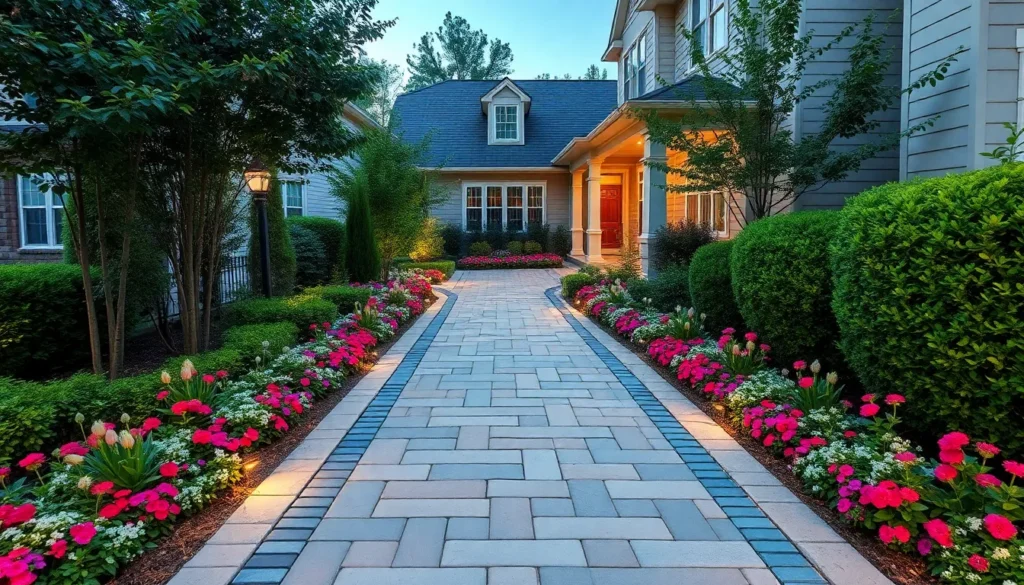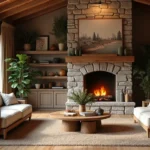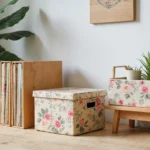Your home’s front walkway sets the stage for every visitor’s experience and creates that all-important first impression. We’ve all walked up to a house and immediately felt drawn in by a beautifully designed path that perfectly complements the home’s architecture and landscaping.
A well-planned front walkway doesn’t just guide guests to your door – it transforms your entire property’s curb appeal and can significantly boost your home’s value. Whether you’re working with a straight shot from the street or handling around existing industry features, the right walkway design becomes a stunning focal point that reflects your personal style.
We’ll explore creative ideas that work with any budget, from simple DIY upgrades to dramatic makeovers that’ll have your neighbors asking for your designer’s contact information. Let’s jump into the walkway answers that’ll make your home the standout on the block.
Elegant Stone Walkway Designs for Timeless Appeal
Stone walkways create sophisticated entrances that enhance your home’s architectural beauty while standing the test of time. These durable materials offer natural texture and color variations that complement any industry design style.
Natural Flagstone Pathways
Flagstone delivers organic beauty with its irregular shapes and earthy color palette. We recommend choosing local stone varieties like sandstone bluestone or limestone to ensure your walkway harmonizes with your region’s natural industry. These materials typically cost between $15 to $25 per square foot installed.
Large format flagstones create dramatic stepping stone effects when spaced 2 to 4 inches apart. Fill the gaps with moss ground cover plants or decorative gravel to soften the overall appearance. The irregular edges provide visual interest while maintaining a sophisticated look that works beautifully with both traditional and contemporary home styles.
Thickness matters significantly for durability and safety. Select flagstones that measure at least 1.5 to 2 inches thick to prevent cracking under foot traffic and weather conditions. Thicker stones also provide better stability when installed over sand or gravel base materials.
Cobblestone Classic Layouts
Cobblestone patterns bring Old Industry charm to modern front entrances. Traditional European layouts like herringbone fan or basket weave create stunning visual appeal that increases property value by 5 to 10 percent according to industry design professionals. These small rounded stones typically measure 4 to 6 inches in diameter.
Installation requires precise attention to base preparation and spacing. We suggest creating a 4 inch deep crushed stone base topped with 2 inches of sand for proper drainage and stability. Joint spacing should remain consistent at approximately 0.5 inches between each cobblestone to ensure uniform appearance.
Granite cobblestones offer superior weather resistance compared to concrete alternatives. Natural granite withstands freeze thaw cycles better than manufactured options while developing an attractive patina over time. Expect to invest $20 to $35 per square foot for authentic granite cobblestone installation.
Stacked Stone Border Accents
Stacked stone borders define walkway edges while adding dimensional interest. Build these decorative elements using flat fieldstone limestone or slate pieces stacked 12 to 18 inches high along both sides of your main pathway. This technique works exceptionally well with gravel concrete or paver center sections.
Dry stacking methods eliminate mortar requirements for easier DIY installation. Select stones with relatively flat surfaces and similar thicknesses to ensure stable construction. Each stone should overlap the joints below it by at least 50 percent to prevent shifting and maintain structural integrity.
Integration with industry lighting enhances evening curb appeal dramatically. Install low voltage LED strip lights or small spotlights behind the stacked stone borders to create warm ambient lighting. This approach highlights the natural texture while providing safety illumination for nighttime navigation along your front walkway.
Modern Concrete Front Walkway Ideas
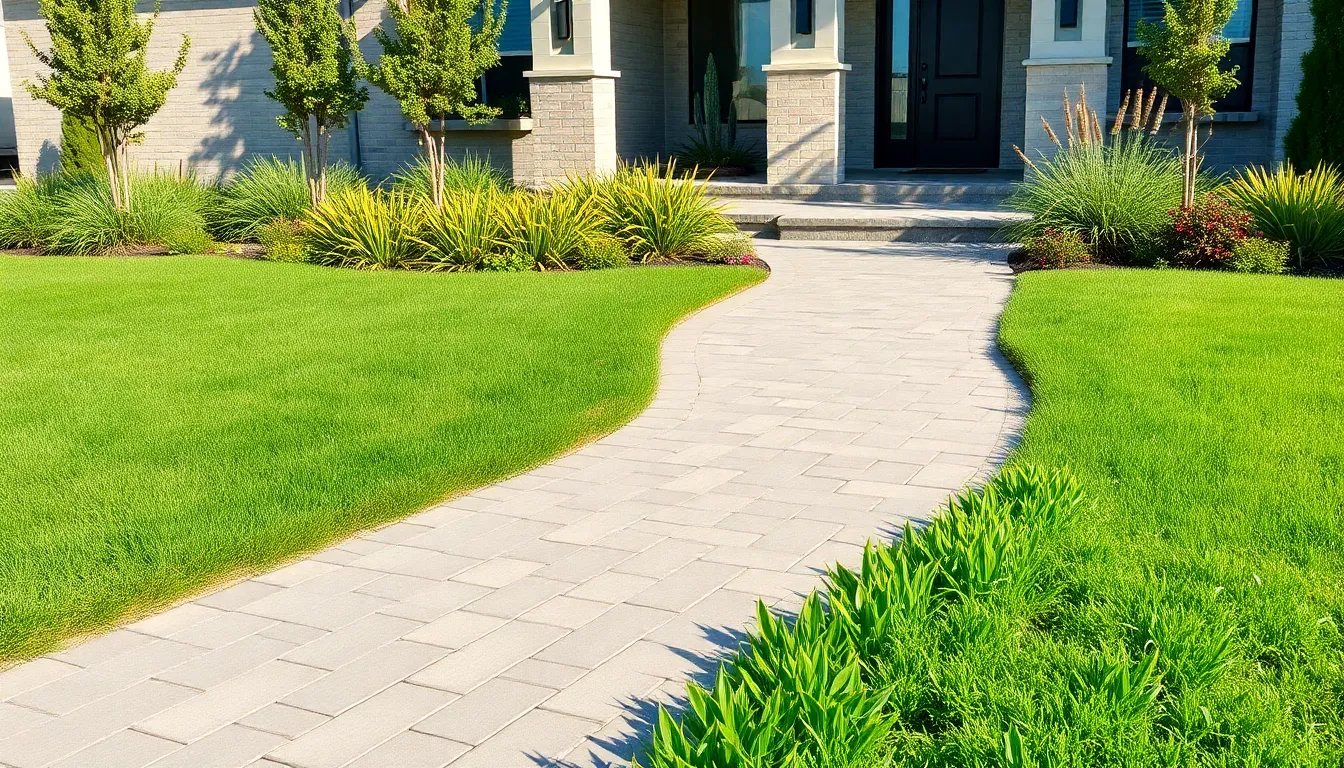
Concrete walkways offer versatility that allows us to create sleek, contemporary entrances while maintaining durability and low maintenance requirements. We can achieve stunning results by combining concrete with natural elements like grass, gravel, or drought-resistant plants for a truly modern aesthetic.
Stamped Concrete Pattern Options
Stamped concrete transforms ordinary walkways into striking focal points by imprinting patterns directly into wet concrete before it sets. Brick patterns create classic appeal, while stone and slate designs offer natural texture without the expense of actual materials. Wood grain stamps provide rustic charm, and geometric shapes deliver contemporary flair that complements modern architecture.
Custom patterns allow us to create unique, personalized walkways that reflect individual style preferences. We can choose from countless design possibilities, ensuring our concrete walkway becomes a distinctive feature rather than a basic path. Popular combinations include alternating patterns or border designs that frame the main walkway area.
Exposed Aggregate Finishes
Exposed aggregate finishes reveal beautiful natural stones or pebbles embedded within the concrete surface, creating texture and visual interest. We achieve this finish by washing away the top cement layer after pouring, which exposes the underlying aggregate materials. This technique provides excellent slip resistance, making it both practical and attractive for front entrances.
Various aggregate sizes offer different aesthetic effects, from fine pebbles that create subtle texture to larger stones that make bold statements. Color combinations range from neutral earth tones to vibrant mixed aggregates that complement exact industry designs. We can select local stones to create walkways that naturally blend with surrounding regional materials.
Colored Concrete Variations
Colored concrete elevates plain walkways through pigments added during mixing or stains applied after installation. Earth tones, grays, and blacks remain popular choices for modern front walkways, while brighter accent colors can match home exteriors or industry features. Integral coloring ensures consistent color throughout the entire concrete thickness, providing long-lasting results.
Surface treatments create multi-tonal effects that add depth and artistic detail to walkway designs. We can apply acid stains for variegated patterns or use water-based stains for uniform color coverage. Color combinations work particularly well when paired with stamped patterns or exposed aggregate finishes, creating layered visual appeal that enhances curb appeal significantly.
Charming Brick Walkway Configurations

Brick walkways bring timeless elegance to any home entrance while offering exceptional durability that lasts for decades. We’ll explore three classic configurations that transform ordinary front paths into stunning focal points.
Traditional Herringbone Patterns
Creating visual drama through zigzag arrangements makes herringbone patterns the most sought after brick walkway design. Installing bricks at 45 degree angles forms interlocking V shapes that provide superior stability compared to straight layouts.
Traction benefits make herringbone ideal for sloped walkways since the angled pattern prevents slipping during wet conditions. We recommend using standard 4×8 inch bricks for optimal pattern definition and structural integrity.
Color variations within herringbone layouts add depth when mixing red clay bricks with buff colored options. Darker border bricks frame the pattern beautifully while creating defined edges that guide visitors naturally toward your entrance.
Running Bond Layouts
Streamlined aesthetics define running bond patterns where bricks align in straight horizontal rows with staggered joints. Each row offsets by half a brick length creating clean lines perfect for modern home styles.
Installation simplicity makes running bond the most budget friendly option since laying straight rows requires fewer cuts and less planning time. We suggest starting with a chalk line to maintain perfect alignment throughout the entire walkway.
Maintenance advantages emerge from running bond’s uniform surface that sheds water efficiently and resists settling issues. Replacing individual bricks becomes straightforward when damage occurs since the pattern doesn’t rely on complex interlocking arrangements.
Circular Medallion Designs
Focal point creation transforms standard walkways when circular medallions feature contrasting materials like natural stone centers surrounded by brick borders. We typically place medallions at pathway intersections or directly in front of main entrances.
Design flexibility allows medallions to incorporate family initials, decorative stones, or intricate geometric patterns that reflect personal style preferences. Standard medallion diameters range from 4 to 8 feet depending on walkway width and overall scale.
Installation considerations require precise measuring and cutting to achieve perfect circular shapes that integrate seamlessly with surrounding brick patterns. Professional installation ensures medallions remain level and properly aligned with the main walkway structure.
Creative Gravel and Decomposed Granite Paths
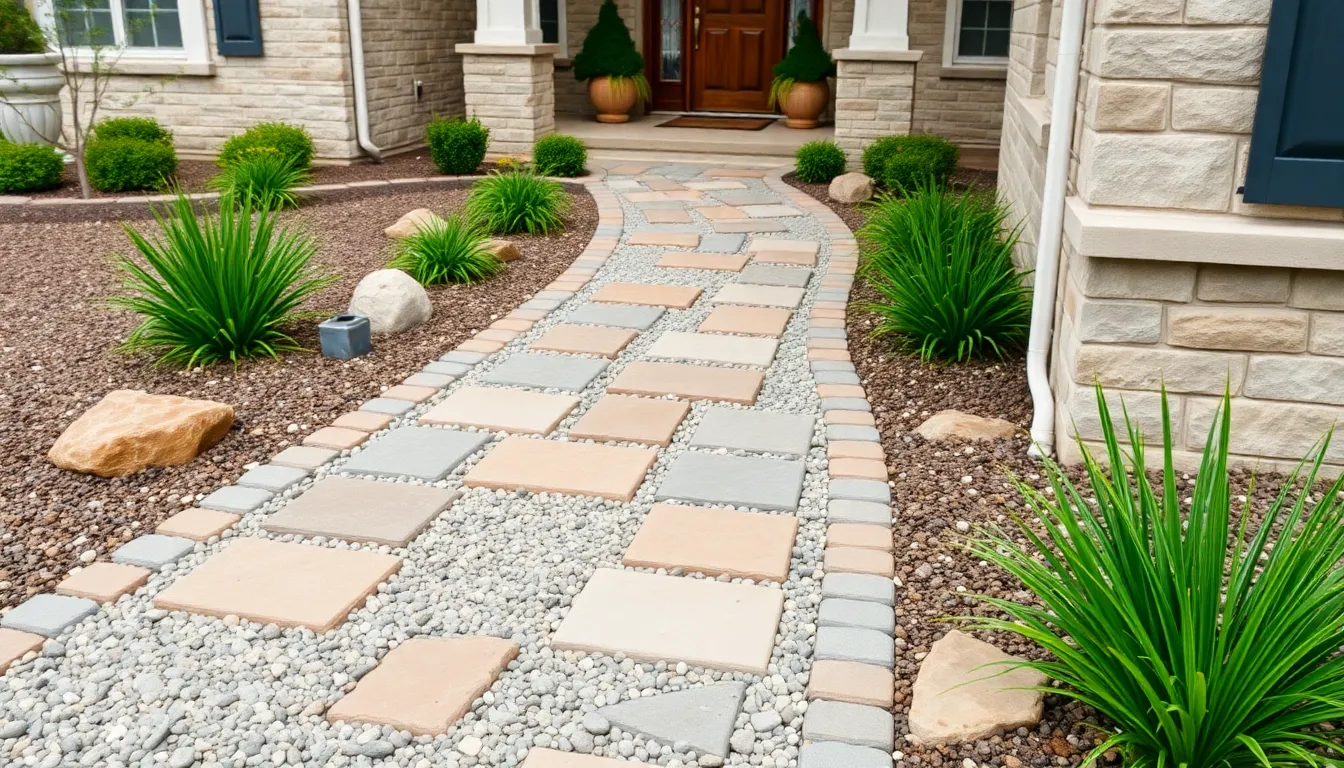
Natural materials like gravel and decomposed granite offer budget-friendly alternatives that maintain sophisticated appeal. These versatile options provide excellent drainage while creating distinctive pathways that complement various architectural styles.
Permeable Gravel Answers
Permeable gravel walkways excel at managing rainwater naturally while eliminating traditional drainage concerns. Water penetrates directly through the material, reducing runoff and preventing erosion around your home’s foundation. These environmentally conscious answers help manage stormwater on-site rather than overwhelming municipal drainage systems.
Standard gravel sizes ranging from 3/8 to 3/4 inches work best for foot traffic and optimal permeability. Larger decorative stones create visual interest but may become uncomfortable for regular walking. Installation requires proper base preparation with industry fabric to prevent weed growth while maintaining water flow.
Stabilized Decomposed Granite
Stabilized decomposed granite delivers superior durability compared to regular loose materials through specialized binding additives. These treatments prevent erosion and particle migration while maintaining the natural appearance homeowners desire. Heavy foot traffic areas benefit significantly from this enhanced stability without sacrificing aesthetic appeal.
Professional-grade stabilizers can extend walkway lifespan by up to 10 years with minimal maintenance requirements. Color options include warm browns, cool grays, and reddish tones that complement different industry designs. Proper compaction during installation ensures long-term performance and prevents surface irregularities.
Mixed Material Combinations
Combining gravel with complementary materials creates unique textures and visual depth in front walkways. Cobblestone borders paired with gravel centers provide historic charm while maintaining cost effectiveness. Flagstone stepping stones embedded in decomposed granite offer both functionality and contemporary appeal.
Popular combinations include:
- Large river rocks with fine gravel fill
- Brick edging with decomposed granite pathways
- Natural fieldstone accents within gravel surfaces
- Concrete pavers alternating with textured stone sections
These mixed approaches allow creative expression while addressing practical concerns like drainage, maintenance, and foot comfort. Strategic placement of larger elements provides stable walking surfaces while smaller materials fill gaps and create cohesive design flow.
Stunning Paver Front Walkway Ideas
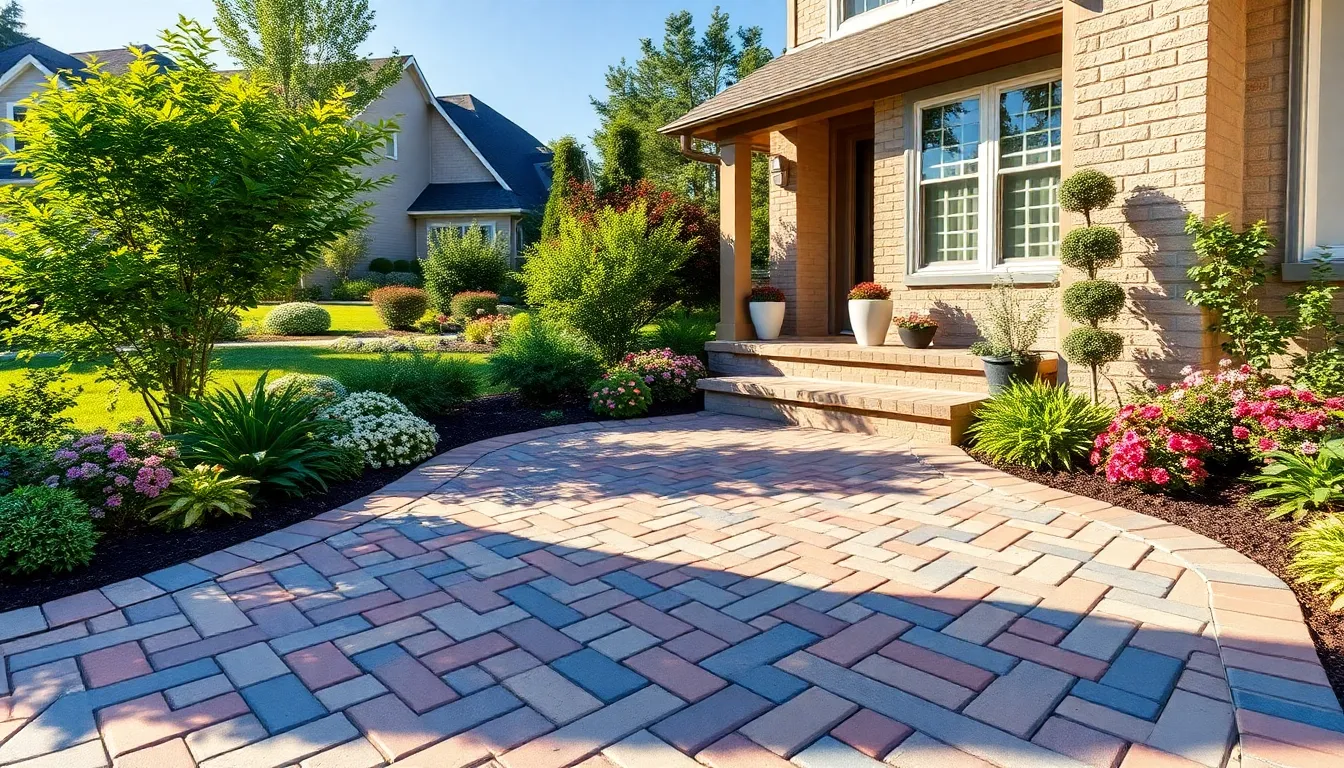
Pavers offer versatility and durability that transforms ordinary front walkways into sophisticated pathways. We’ll explore three exceptional paver approaches that enhance both functionality and visual appeal.
Interlocking Paver Systems
Interlocking paver systems provide exceptional durability while simplifying installation processes. These systems create various stunning patterns like herringbone or running bond designs that add visual interest to walkways. Installation becomes more manageable because the pavers lock together naturally, reducing shifting and settling over time.
Heavy foot traffic poses no challenge for properly installed interlocking systems. The interconnected design distributes weight evenly across the surface, preventing individual pavers from becoming loose or uneven. Maintenance requirements remain minimal since damaged sections can be easily replaced without disturbing surrounding areas.
Pattern versatility allows homeowners to customize their walkway appearance completely. Running bond patterns create clean, streamlined looks that complement modern architecture. Herringbone arrangements add traditional elegance while providing superior traction on sloped walkways.
Permeable Paver Options
Permeable pavers excel at managing rainwater while reducing environmental impact significantly. Cobblestone pavers create natural drainage through gaps between stones, allowing rainwater to infiltrate the ground effectively. This permeability reduces stormwater runoff that can cause erosion and flooding issues around your home.
Environmental benefits extend beyond simple water management capabilities. Rainwater infiltration helps recharge local groundwater supplies while filtering pollutants naturally through soil layers. These systems prevent water from overwhelming municipal drainage systems during heavy rainfall events.
Installation considerations ensure optimal performance for decades ahead. Proper base preparation with graded aggregate allows water to flow freely beneath the paver surface. Regular maintenance involves keeping gaps clear of debris that could block water infiltration pathways.
Multi-Color Paver Patterns
Multi-color paver arrangements create visually striking walkways that enhance curb appeal dramatically. Herringbone patterns become more ever-changing when alternating between complementary colors that add depth and dimension. Interlocking designs benefit from strategic color placement that emphasizes geometric patterns.
Border applications using contrasting colors enhance the overall walkway aesthetic significantly. Darker border pavers frame lighter center sections, creating defined pathways that guide visitors naturally. Color combinations should complement your home’s exterior palette while maintaining sufficient contrast for visual impact.
Pattern complexity can range from subtle variations to bold geometric statements. Simple alternating colors create understated elegance suitable for traditional homes. Complex multi-color arrangements work well with contemporary architecture that embraces bold design elements.
Unique Wood and Composite Walkway Solutions
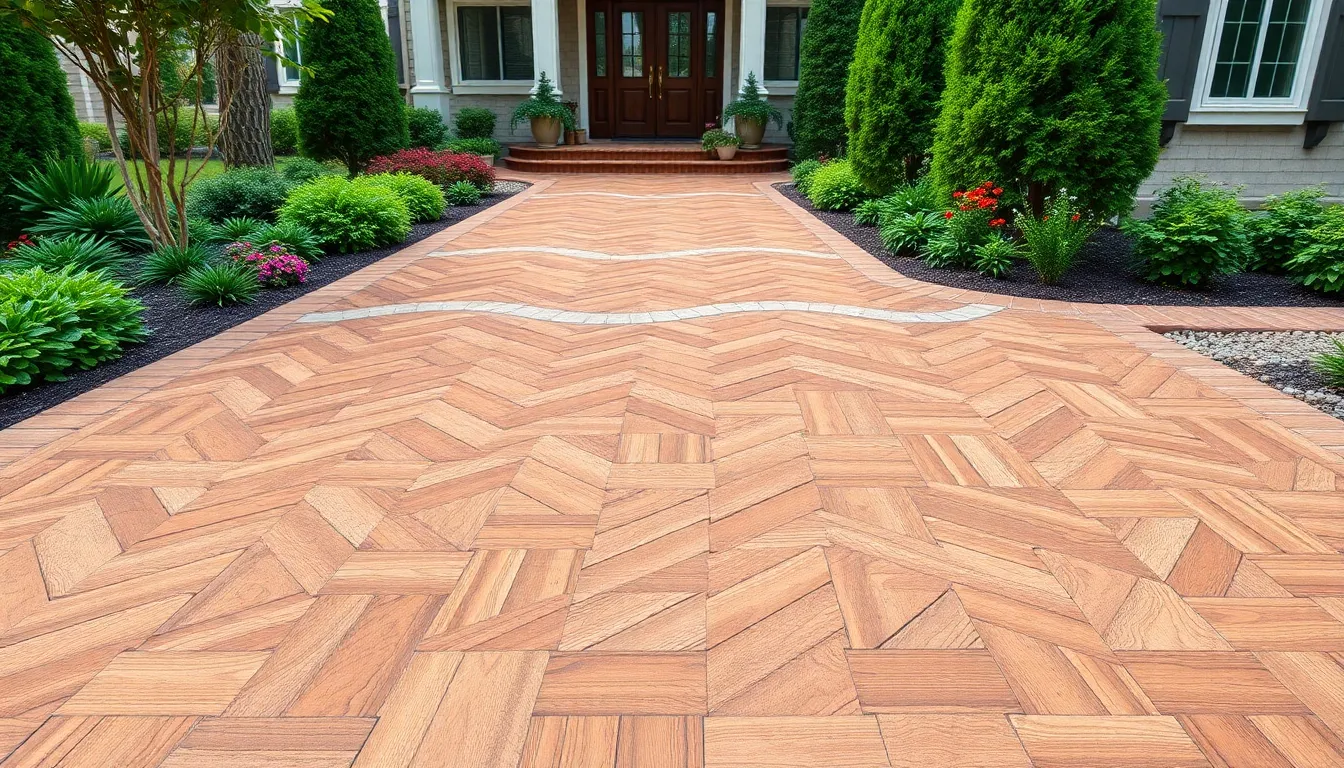
We’re exploring warm, natural materials that bring organic beauty to your front entrance while offering exceptional durability.
Hardwood Decking Pathways
Hardwood walkways transform ordinary entrances into stunning focal points using premium materials that resist rot and insects. Ipe, teak, and cedar species provide exceptional longevity while maintaining their rich, natural appearance over time. We recommend arranging boards in herringbone patterns to create visual drama and enhance traction on sloped approaches.
Linear installations offer streamlined aesthetics that complement modern architectural styles perfectly. Hardwood pathways require periodic sealing to maintain their weather resistance and color vibrancy. Installation involves proper spacing between boards to allow for natural expansion and contraction cycles.
Composite Material Benefits
Composite walkways combine wood fibers with plastic materials to create low maintenance pathways that resist mildew and mold growth. These engineered materials require significantly less upkeep compared to traditional wood options while delivering similar aesthetic appeal. We’ve found composite pathways maintain their appearance without regular staining, sealing, or replacement concerns.
Moisture resistance makes composite materials ideal for areas with challenging weather conditions or high humidity levels. Manufacturers design composite boards to mimic natural wood grain patterns while providing superior durability against fading and scratching. Color consistency remains stable throughout the material’s lifespan, eliminating concerns about surface wear revealing different tones underneath.
Boardwalk Style Designs
Boardwalk walkways recreate coastal charm using individual planks laid side by side to form rustic, welcoming pathways. This design approach works beautifully with both hardwood and composite materials, offering flexibility in budget and maintenance preferences. We suggest incorporating slight gaps between boards to promote drainage and prevent water accumulation.
Coastal themed landscapes benefit tremendously from boardwalk styling that evokes seaside relaxation and natural beauty. Elevated boardwalk sections can navigate uneven terrain while protecting underlying landscaping from foot traffic damage. Beach house aesthetics translate perfectly to suburban settings, creating unique curb appeal that distinguishes your home from traditional paved walkways.
Budget-Friendly Front Walkway Ideas
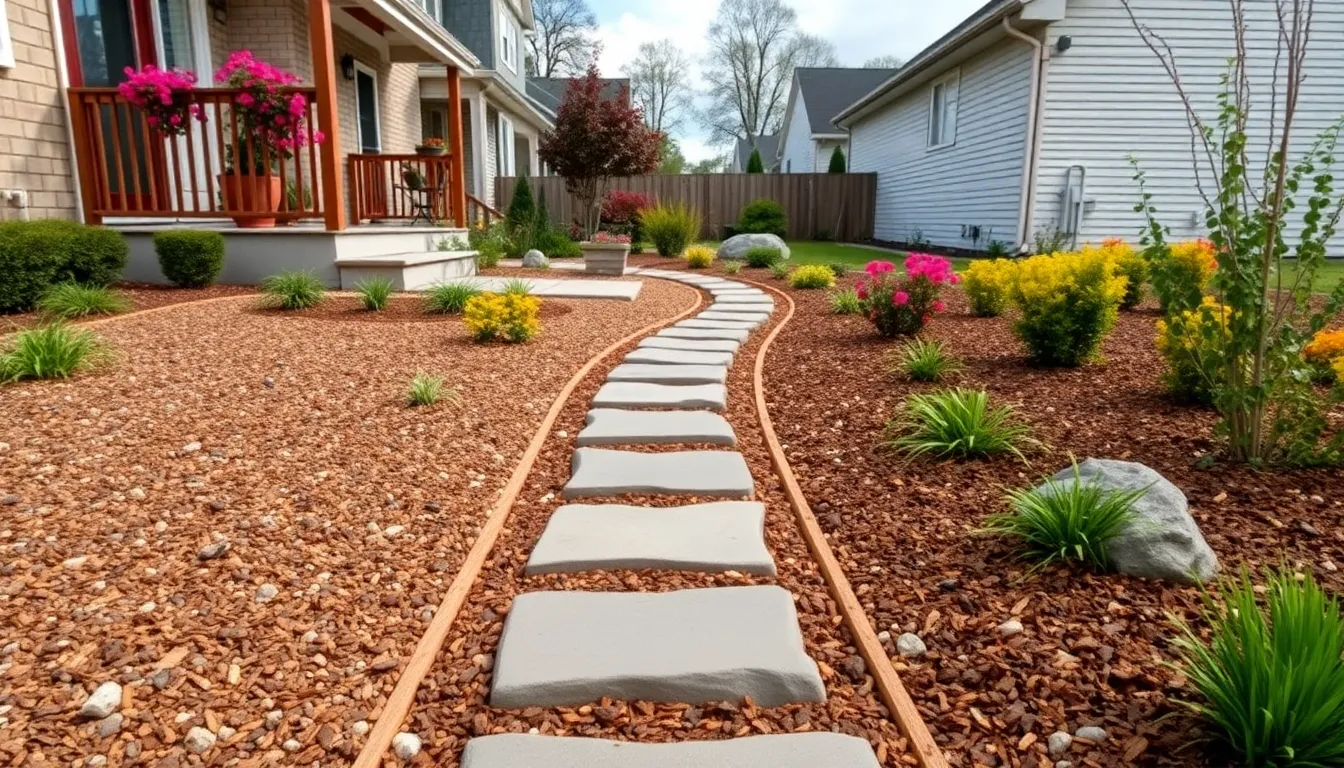
Creating a beautiful front walkway doesn’t require very costly. We’ve discovered several cost-effective approaches that deliver impressive results while keeping expenses minimal.
DIY Stepping Stone Projects
DIY stepping stones offer incredible value while allowing complete creative control over your walkway design. Pouring concrete into large boulder-shaped molds creates authentic-looking stones that mimic expensive natural materials at a fraction of the cost. Plastic molds with cement produce faux stones that deliver genuine appearances while maintaining budget-friendly pricing.
Cedar edging combined with evenly spaced stepping stones creates a polished look that’s surprisingly affordable. White landscaping rock placed between stones adds texture and stability while requiring minimal maintenance. We recommend spacing stones 18-24 inches apart to accommodate natural walking strides.
Interspersing stepping stones with gravel or wood chips enhances both visual appeal and functionality. This combination provides excellent drainage while creating interesting textural contrasts that elevate the overall design aesthetic.
Mulch and Wood Chip Paths
Mulch paths deliver soft, permeable surfaces that blend seamlessly with garden environments. These materials create comfortable walking surfaces while allowing rainwater to penetrate naturally into the soil below. Wood chips provide similar benefits with slightly more durability against heavy foot traffic.
Annual replenishment keeps mulch walkways looking fresh and well-maintained throughout the seasons. We suggest choosing materials that complement your existing industry palette for optimal visual cohesion. Both options work exceptionally well for informal or winding garden paths that follow natural terrain contours.
Maintenance requirements remain minimal with occasional edge trimming to keep pathways looking neat and defined. Installing simple border materials like stones or industry edging helps contain the mulch while creating cleaner lines.
Recycled Material Options
Recycled materials transform ordinary walkways into unique features while supporting environmental sustainability. Old bricks, broken concrete pieces, and reclaimed wood serve as excellent stepping stones or pathway borders that add distinctive character. These materials often cost significantly less than new alternatives while providing comparable durability.
Recycled rubber mulch offers superior drainage and exceptional longevity compared to traditional organic mulches. This sustainable option resists decomposition while maintaining consistent appearance year after year. We’ve found it particularly effective in high-traffic areas where traditional mulch might break down quickly.
Incorporating reclaimed elements creates conversation pieces that reflect personal style and environmental consciousness. Mixing different recycled materials adds visual interest while keeping costs low and reducing waste that would otherwise end up in landfills.
Landscaping Integration for Enhanced Curb Appeal

We can transform our front walkway from a simple path into a stunning industry feature that seamlessly blends with our home’s overall design. Strategic plant placement and thoughtful design elements create cohesive outdoor spaces that welcome guests while boosting property value.
Bordered Plantings and Edging
Flower borders create visually appealing and colorful edges that frame our front walkways beautifully. We recommend planting seasonal blooms like tulips, marigolds, and petunias along walkway edges to add vibrant pops of color throughout the year. These plantings guide the eye naturally toward our front entrance while creating defined boundaries.
Edging materials like brick, stone, or metal help define plant beds and create clean, professional looking lines. Metal edging offers the most precise definition and prevents grass from encroaching into planted areas. Stone edging provides a more natural appearance that complements organic industry designs, while brick edging creates classic appeal that matches traditional home styles.
Evergreen plants or hedges along walkways provide year round greenery and consistent texture regardless of season. Boxwood, lavender, and ornamental grasses maintain their structure through winter months, ensuring our walkway looks polished even when flowering plants go dormant. These permanent plantings create reliable framework that supports seasonal color changes.
Lighting Design Considerations
Pathway lighting transforms our front walkway into an inviting beacon that provides both functionality and aesthetic appeal during evening hours. Solar powered lights offer energy efficient answers that automatically illuminate walkways without increasing electricity costs. Low voltage LED fixtures deliver consistent brightness while consuming minimal power and lasting for years.
Accent lighting using spotlights highlights exact industry features like large trees, architectural elements, or garden beds near our walkway. We position these fixtures to create dramatic shadows and depth that enhance the overall ambiance. Uplighting techniques can showcase specimen plants or textured surfaces, while downlighting provides practical illumination for safe navigation.
Timer controlled systems ensure our walkway lighting operates consistently without daily management. Smart lighting options allow us to adjust brightness levels and schedules remotely, adapting to seasonal changes or special occasions. Warm white LEDs create welcoming atmospheres that complement most industry designs better than cool white alternatives.
Seasonal Color Additions
Seasonal planters positioned strategically along our walkway add color and interest that changes throughout the year. Spring containers filled with tulips, daffodils, and pansies create fresh, vibrant displays after winter months. Summer planters featuring impatiens, begonias, and coleus provide continuous color in shaded areas, while sun loving petunias and marigolds thrive in brighter locations.
Ornamental grasses and seasonal flowers add texture and movement that creates ever-changing visual interest along walkway borders. Fountain grass, feather reed grass, and purple muhly grass provide architectural structure while swaying gently in breezes. These grasses pair beautifully with seasonal annuals like mums in fall and ornamental kale in winter.
Rotating seasonal displays keep our front walkway looking fresh and well maintained throughout the year. We suggest changing container plantings at least three times annually to maintain peak visual impact. Fall displays featuring chrysanthemums, ornamental peppers, and decorative gourds create warm, welcoming autumn scenes that complement harvest themes.
Maintenance Tips for Long-Lasting Walkways

Maintaining your front walkway properly ensures it remains beautiful and functional for years to come. Regular care prevents costly repairs and keeps your home’s curb appeal at its peak.
Seasonal Care Requirements
Spring maintenance begins with cleaning away winter debris and weeds that accumulated during the colder months. Apply a fresh coat of sealer if you notice fading or wear from winter weather exposure. Power washing removes salt residue and grime that built up over winter months.
Summer care focuses on regular sweeping and hosing down surfaces to prevent dirt buildup. Schedule weekly debris removal to maintain your walkway’s appearance during high traffic months. Check for any settling or shifting that may have occurred from spring thaw.
Fall preparation involves clearing leaves and organic matter that can stain surfaces permanently. Remove all debris before it decomposes and creates unsightly marks on your walkway materials. Apply pre-winter sealer to protect against freeze thaw cycles.
Winter protection requires using concrete safe ice melt products to prevent surface damage from freezing temperatures. Choose deicing products specifically designed for your walkway material to avoid costly spring repairs. Clear snow promptly to prevent ice formation and reduce slip hazards.
Repair and Restoration Methods
Stain removal techniques vary depending on the type of discoloration you’re addressing. Use baking soda paste for oil stains, allowing it to sit overnight before scrubbing away. Lemon juice combined with salt effectively removes rust stains from most walkway surfaces.
Mold and mildew require bleach answers applied carefully to avoid damage to surrounding plants. Scrub affected areas with a stiff brush after letting the solution work for 10 to 15 minutes. Rinse thoroughly to prevent chemical residue from affecting nearby landscaping.
Surface repairs demand matching materials to maintain a cohesive appearance across your entire walkway. Replace damaged sections immediately to prevent further deterioration and safety hazards. Fill cracks with appropriate compounds before they expand and require major reconstruction.
Professional restoration becomes necessary when damage exceeds basic repair capabilities. Consider hiring specialists for extensive crack repair, releveling, or complete section replacement. Investment in professional work often proves more cost effective than multiple DIY attempts.
Preventive Maintenance Strategies
Regular inspection schedules help you catch problems before they become expensive repairs. Walk your entire pathway monthly, looking for cracks, settling, or loose materials that need attention. Document any changes with photos to track progression over time.
Weed control prevents plant growth from compromising your walkway’s structural integrity. Remove weeds immediately when you spot them growing between stones, pavers, or cracks. Apply pre-emergent herbicides in early spring to prevent seed germination.
Edge maintenance keeps grass and vegetation from encroaching on walkway boundaries. Use a powered edger regularly to maintain clean lines and prevent root systems from undermining your pathway. Sharp edges also enhance the overall appearance of your front entrance.
Drainage management protects your walkway from water damage and settling issues. Clear drainage channels and ensure proper water flow away from walkway surfaces. Address any pooling water immediately to prevent freeze damage and material deterioration.
Conclusion
Your front walkway represents more than just a path to your door—it’s the foundation of your home’s first impression and a reflection of your personal style. Whether you’re drawn to the timeless elegance of natural stone the modern appeal of concrete pavers or the warm charm of wood and composite materials there’s a perfect solution waiting for your unique space.
We’ve explored options for every budget from simple DIY stepping stones to sophisticated mixed-material designs that create lasting curb appeal. Remember that the best walkway combines functionality with beauty while complementing your home’s architecture and your family’s lifestyle.
With proper planning regular maintenance and attention to landscaping integration your new front walkway will serve as a welcoming entrance that enhances your property value for years to come. Start planning your transformation today and create the impressive entrance your home deserves.
Frequently Asked Questions
What materials are best for creating a durable front walkway?
Natural stone, concrete, brick, and interlocking pavers offer excellent durability for front walkways. Stone and brick provide timeless appeal with minimal maintenance, while concrete offers versatility with stamped patterns and colors. Pavers are particularly popular due to their easy installation and repair capabilities, making them ideal for high-traffic areas.
How much does it cost to install a new front walkway?
Front walkway costs vary significantly based on materials and size. Budget-friendly options like gravel or mulch paths cost $2-5 per square foot, while mid-range concrete or basic pavers range from $8-15 per square foot. Premium materials like natural stone or elaborate designs can cost $20-40 per square foot, including professional installation.
Can I install a front walkway myself or do I need a professional?
Many walkway projects are DIY-friendly, including stepping stones, gravel paths, and basic paver installations. However, complex designs, concrete pouring, or projects requiring drainage solutions typically need professional installation. Consider your skill level, available time, and local building codes when deciding between DIY and professional installation.
What’s the best walkway width for a front entrance?
The ideal front walkway width is 4-6 feet, allowing two people to walk comfortably side by side. Narrower paths (3-4 feet) work for smaller properties, while wider walkways (6-8 feet) create more dramatic entrances for larger homes. Consider your home’s scale and the expected foot traffic when determining width.
How do I choose walkway materials that complement my home’s style?
Match your walkway materials to your home’s architectural style and existing materials. Traditional homes pair well with brick or natural stone, while modern homes suit sleek concrete or geometric pavers. Consider your home’s color palette, roof materials, and landscape design to create a cohesive look that enhances overall curb appeal.
What maintenance do different walkway materials require?
Maintenance varies by material: concrete needs periodic sealing and crack repair, natural stone requires occasional re-pointing and stain removal, while pavers may need sand replacement and weed control. Gravel paths need regular raking and replenishment. Most materials benefit from regular cleaning, seasonal inspections, and prompt repair of any damage.
How can I improve drainage around my front walkway?
Improve walkway drainage by ensuring proper grading away from your home, installing permeable materials like gravel or permeable pavers, and adding drainage channels or French drains where needed. Avoid creating low spots where water can pool, and consider materials that naturally shed water rather than absorbing it.
What lighting options work best for front walkways?
Solar-powered LED lights offer easy installation without electrical work, while low-voltage LED systems provide more reliable illumination. Consider path lights, uplights for landscaping, and step lights for safety. Space fixtures 6-8 feet apart for even coverage, and choose warm white LEDs (2700-3000K) for welcoming ambiance.
How do I incorporate landscaping with my front walkway design?
Frame your walkway with flower borders, evergreen shrubs, or decorative edging materials. Use plants to soften hard surfaces and create visual interest throughout seasons. Consider plant height, bloom times, and maintenance requirements. Add planters or garden beds at key points to create focal areas and guide visitors naturally toward your entrance.
When is the best time to install or renovate a front walkway?
Spring and fall offer ideal conditions for walkway installation, with moderate temperatures and lower chance of extreme weather. Avoid winter installation in freezing climates, as concrete and mortar don’t cure properly in cold temperatures. Summer installation is possible but may require additional water management and protection from extreme heat during material curing.

